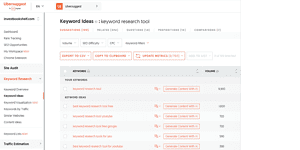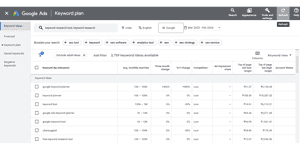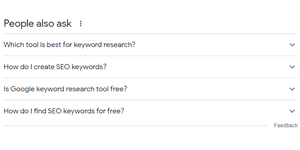Keyword research is the cornerstone of any successful SEO strategy. By identifying the right keywords, you can optimize your website to attract relevant traffic and improve your search engine rankings. However, conducting effective keyword research requires more than just typing words into a search bar. In this blog post, we'll explore 10 keyword research techniques that can help you achieve SEO success.
Understand Your Audience:
Before diving into keyword research tools, take the time to understand your target audience & niche. What are their interests, pain points, and preferences? By understanding your audience's needs, you can identify keywords that align with their search intent. For example, if you run a fitness blog targeting beginners, keywords like "easy workouts for beginners" or "beginner-friendly fitness tips" would be relevant.
Find Seed Keywords:
In the initial stages of keyword research, it's crucial to brainstorm seed keywords to lay a solid foundation for your strategy. Seed keywords are broad terms or phrases that are directly related to your business or industry.
Seed keyword are starting point for further keyword exploration and help you uncover relevant search queries. To brainstorm seed keywords effectively, consider your target audience, industry trends, and core offerings.

Utilize tools like Google Keyword Planner or simply jot down ideas based on your industry knowledge. These seed keywords will guide your research and pave the way for discovering more specific and high-potential keywords.
Use Keyword Research Tools:
Utilize keyword research tools to expand your list of keywords and gather valuable insights. Tools like Google Keyword Planner, SEMrush, Ahrefs, Ubber Suggerst and Moz Keyword Explorer provide data on search volume, keyword difficulty, and related keywords. Experiment with different tools to uncover hidden opportunities and identify high-potential keywords for your SEO strategy.
Example of keyword research tool like Ubber Suggest
Google Keyword Planner - It is a powerful tool designed to aid in keyword research and planning for Google Ads campaigns. It offers valuable insights into keyword search volume, competition, and bid estimates, making it an essential resource for advertisers and SEO professionals alike. With Google Keyword Planner, users can generate new keyword ideas, explore keyword trends, and refine their keyword lists based on relevant metrics.
Additionally, the tool provides historical data and forecasts to help users make informed decisions about their advertising strategies. Whether you're launching a new campaign or optimizing an existing one, Google Keyword Planner is an indispensable tool for maximizing your advertising ROI and improving your website's visibility in search results.
Analyze Competitor Keywords:
Study your competitors' websites to identify keywords they're ranking for. Tools like SEMrush, Ahref and SpyFu allow you to view the organic keywords driving traffic to your competitors' sites. Analyzing competitor keywords can help you discover
untapped keyword opportunities and gain insights into your industry landscape.
Understanding competitor keywords allows you to refine your SEO tactics, prioritize high-value keywords, and create targeted content to outrank competitors. It's a crucial step in optimizing your website's visibility and attracting relevant traffic from search engines.
Consider Long-Tail Keywords:
Don't overlook the power of long-tail keywords in your keyword research strategy. Long-tail keywords are longer, more specific phrases that typically have lower search volume but higher conversion rates. They often reflect user intent more accurately and can help you target niche audiences. Incorporate long-tail keywords into your content to capture valuable traffic.
Leverage Google Autocomplete and Related Searches:
Take advantage of Google's autocomplete feature and related searches to discover additional keyword ideas. Start typing your seed keywords into Google's search bar to see suggested search queries. These suggestions are based on real user searches and can provide valuable insights into popular search terms in your niche.
By paying attention to these autocomplete suggestions, you can uncover new keyword ideas and understand the search intent behind them. Incorporating these autocomplete suggestions into your keyword strategy enables you to target long-tail keywords and capture highly relevant traffic.
Additionally, Google Autocomplete can help you identify emerging trends and topics of interest to your audience, allowing you to stay ahead of the curve in your content creation efforts.
Google's Related Searches keyword feature
Google's Related Searches feature is a powerful technique in keyword research. Located at the bottom of the search results page, Related Searches display additional queries related to the initial search term. These suggestions offer valuable insights into related topics and variations of the main keyword.
By analyzing Related Searches, you can identify new keyword opportunities and understand the broader context of your target topic. Adding these related keywords into your content strategy can help diversify your keyword portfolio and attract a wider audience. It's a simple yet effective way to expand your keyword research and optimize your content for better search visibility.
People Also Asked Keywords
Analyzing "People Also Asked" (PAA) queries on Google is an invaluable method for keyword research. These are displayed as a series of questions related to the initial search query, providing insight into the specific information users are seeking. By examining PAA keywords, you can identify relevant topics to cover in your content and optimize for user intent.
Adding these questions to your content strategy not only enhances your SEO efforts but also helps address users' queries comprehensively. Moreover, addressing PAA queries can increase your chances of earning featured snippets, enhancing your visibility and authority in search results.
Use Google Trends:
Monitor trending topics and seasonal fluctuations in search interest with Google Trends. This tool allows you to compare the popularity of different keywords over time and identify emerging trends. By staying ahead of the curve, you can tailor your content to capitalize on trending topics and attract more traffic to your website.
Incorporate Semantic SEO:
Expand your keyword research beyond exact match keywords by incorporating semantic SEO principles. Semantic SEO focuses on understanding the context and meaning behind search queries rather than just individual keywords. Use tools like LSI Graph to identify semantically related keywords and create content that addresses a variety of user queries.
Prioritize Intent-Based Keywords:
Focus on targeting keywords that align with user intent at different stages of the buyer's journey. Consider the intent behind each keyword (e.g., informational, navigational, transactional) and tailor your content accordingly. By addressing user intent effectively, you can attract qualified traffic and improve your conversion rates.
Informational Keywords -
Informational keywords signal users' intent to seek knowledge or answers. They typically begin with terms like "how to," "what is," or "guide to." For instance, "how to bake a cake" or "best travel destinations." Crafting content optimized for informational keywords helps attract users in the research phase, positioning your website as a valuable source of information and driving organic traffic.
Navigational keywords -
It indicate users' intent to locate specific websites or resources. They often include brand or domain names, such as "Facebook login" or "Amazon Prime." Optimizing for navigational keywords ensures users find your website easily when searching for your brand or related terms, enhancing brand visibility and user experience. It's essential for businesses to prioritize navigational keyword optimization for better online presence.
Transactional keywords -
Transactional Keywords signal users' intent to take a specific action, such as making a purchase or signing up for a service. Examples include "buy iPhone online" or "book flight to Paris." Targeting transactional keywords is crucial for e-commerce and service-based businesses, driving high-intent traffic that is more likely to convert. Optimizing content for transactional keywords enhances sales and leads generation efforts.
Long-Tail Keywords:
Long-tail keywords are longer and more specific keyword phrases that visitors are more likely to use when they are closer to a point of purchase or when using voice search. Examples include “best organic coffee shops in New York” or “how to train a puppy to sit.” While they attract less traffic, they tend to have a higher conversion rate because they are more specific. Optimizing for long-tail keywords can help capture niche audiences and drive highly targeted traffic to your site.
Analyze and Refine:
Keyword research is an ongoing process that requires continuous analysis and refinement. Regularly monitor your keyword rankings, traffic patterns, and conversion metrics to evaluate the effectiveness of your SEO efforts. Adjust your keyword strategy as needed based on performance data and evolving market trends.
Conclusion:
Effective keyword research is essential for driving organic traffic and achieving SEO success. By implementing these 10 keyword research techniques, you can identify the right keywords to optimize your website and attract your target audience. Keep experimenting, analyzing, and refining your keyword strategy to stay ahead of the competition and maximize your online visibility.
Remember, keyword research is just one piece of the SEO puzzle. Combine it with high-quality content, on-page optimization, and other SEO best practices to create a comprehensive strategy that delivers results. Start implementing these techniques today and watch your website climb the search engine rankings.








